|
We were nineteen intrepid scientists. We had interests in water column hydrography, nutrients, plankton, birds, and marine mammals. We were the plankton team and the upper trophics team (birds and mammals) of the GLOBEC Northeast Pacific (NEP) process study in the California Current System (CCS). Our home for 17 days was to be the RV New Horizon. Our colleagues would be joining us in the CCS on two other vessels: the RV Wecoma and the FV Sea Eagle. RV stands for 'Research Vessel'. Both the New Horizon and the Wecoma are UNOLS supported research vessels. The New Horizon is operated by Scripps (UCSD); the Wecoma is operated by Oregon State University. The FV stands for 'Fishing Vessel' - the Sea Eagle is a private, commercial trawler, that was chartered by GLOBEC to conduct fish sampling.
|
|
|
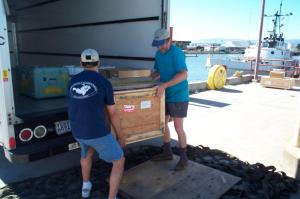
|
The New Horizon departure port was Redwood City, CA - in the South Bay area. Some of us arrived by truck with lots of gear. Here the Chief Scientist, Bill Peterson of OSU and the National Marine Fisheries Service, proudly displays his well worn Secchi disk. Bill says, "Don't leave home without it!".
|

|

|
Jay Peterson (Univ. Minn.) flew in early and helped unload the truck and move gear on board. Here, Jay sees to the loading of the bongo frame. The bongo was a spare in case some of the primary equipment failed. We didn't use it. The crane was operated by Shad Baiz, one of the Resident Marine Technicians from Scripps.
|

|
|
After the gear is transferred to the ship, the interior lab spaces must be set up, and everything stowed and secured. The entire science party is involved in this. The sooner we secure everything, the sooner we can depart. On this cruise the scientific teams consisted of:
Plankton Team - Bill Peterson, Julie Keister, Leah Feinberg, Jaime Gomez-Guttierez, Hal Batchelder, Jay Peterson, Rob Campbell, Andrew King, Karen Haberman, Anders Roestad, and Se Jong Ju.
Bird Team - Dave Ainley and Larry Spear
Marine Mammal Team - Cyndy Tynan, Todd Pusser, Michael Newcomer, and Greg Krutzikowsky.
We were ably assisted by two Scripps technicians, Shad Baiz and Jim Schmidt, and by the remainder of the ships crew.
To the right (from left to right) are Rob, Andrew, Jay, and Anders in the ship's main lab. You will meet all of these scientists in the pictures that follow.
|

|
We're off! We left sunny Redwood City and headed north.
|

|
Our study region was the coastal waters off Northern California and central and southern Oregon--basically from Crescent City, CA to Newport, OR. Redwood City to Crescent City is about 40 hours at the ships cruising speed of 10 kts, if the weather was favorable. The weather was pleasant during the trip north, leaving time for diverse activities. Here Julie (OSU) keeps in shape, while Bill recreates a little less strenuously. David (shown here) and Larry used the time to work on manuscripts and data they had collected previously.
|
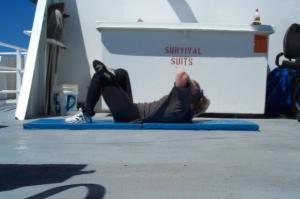
|
|
|

|
|
CTD Central
|
|
For the plankton team, our primary goal on this research cruise were to document the distribution of zooplankton, in particular the euphausiids and larger copepods, in relation to the physical structure of the coastal ocean (extending out about 100 miles from shore), including vertical (thermocline) and horizontal (fronts) variability. We did this by sampling the physics and biology of the ocean. Description of the physical structure of the ocean was primarily a task for the physical group on the RV Wecoma, but we deployed CTDs (Conductivity-Temperature-Depth) to measure water column properties. The CTD was equipped with a rosette water sampler to obtain in situ water for measuring extracted chlorophyll and nutrient concentrations. Water sampling was needed to support the physical observations being made by the Wecoma, since their package did not collect water. Biological sampling was accomplished using a MOCNESS (see below) and smaller plankton nets.
|
A Friendly Competition
Ten plankton team members were divided into two 12-hr watches of 5 members each. The A-Team was captained by Julie and included also Leah, Jaime, Rob and Se Jong. The B-Team was captained by Hal and included also Anders, Andrew, Karen and Jay. There was a friendly rivalry between the two watches to see who could do the 'perfect watch'. A perfect watch was defined as a mistake free [no mistripped bottles; no 45 deg angles on 'vertical' plankton tows], busy and productive watch. And no unfilled blanks (missing info) on the station log sheets!
|
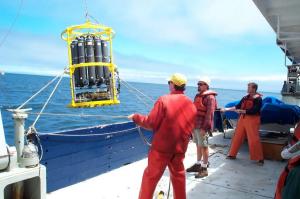
|
The B-Team CTD'd On the left, Hal, Shad and Anders put over the package.
The A-Team CTD'd On the right, Shad and Rob put the CTD over the side.
The B-Team watch was from noon->midnight; A-Team was midnight-->noon. The technicians worked differently, with Shad working 7AM-7PM and Jim working 7PM to 7AM. Several taglines are used to control the package during deployment and retrieval.
|

|
We CTD'd at night.
Rob eyes the camera and Se Jong draws water for nutrients and chlorophyll extractions.
|
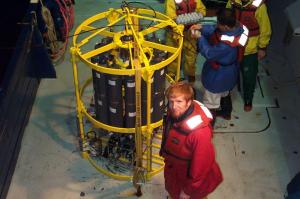
|
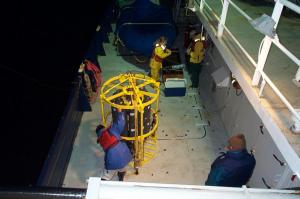
|
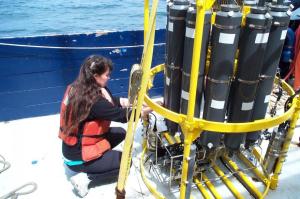
|
Once we even got the bird and mammal observers (Cyndy and Dave) to draw water from the rosette bottles and...
|
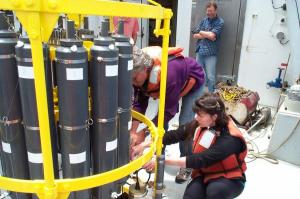
|

|
...filter chlorophyll samples.
|

|
The Mammal Observing Team
|
Mammal Observing
|
When they were not filtering samples in the lab, the mammal team (shown at right (left to right)) of Greg, Todd, Cyndy, and Mike would watch through binoculars and 'BigEyes'. The BigEyes were binocular scopes with approx. 30X magnification, which in clear conditions allowed the observers to see and identify mammals (and birds sometimes) as much as 8-10 miles from the ship. The observers would rotate through the two scopes and binocular positions frequently to avoid fatigue. The sighting platform was located above the bridge (on the 'flying bridge'). Mammal (and bird) observing was done only while the ship was underway to avoid the ship attraction effect.
|
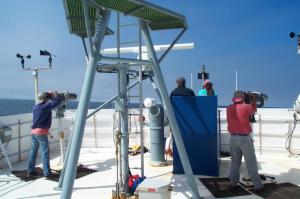
|
|
Viewing conditions were not often as ideal as shown here--flat seas, clear sky, little haze, sunny and warm. More commonly, times of flat seas were times of fog, either limiting visibility or requiring evacuation of the flying bridge so that the radar could be used. Conversely, clear days were often windy and with high sea state, which rolled and moved the ship vertically, making sightings of whales difficult.
|

|

|
MOC Around the Clock
|
MOCNESS
One of the primary tools of the plankton teams was the MOCNESS, which is an acronym for Multiple Opening Closing Net Environmental Sampling System. We used a 1-meter MOCNESS (MOC for short), which means that the mouth area during towing at a 45 degree wire angle is 1 square meter. In the images to the right, Jay, Karen and Shad prepare to deploy the MOC from the fantail of the ship.
|

|
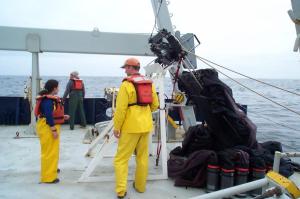
|
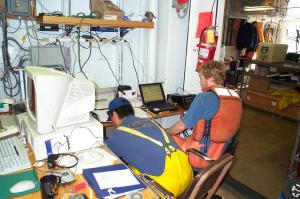
|
The MOC we used had 10 nets that could be closed/opened by electronic command from the controlling computer in the lab. Here Andrew and Anders "fly" the MOC from the lab.
|
|
|
The MOC nets were all of 0.333 mm mesh, an ideal size for capturing euphausiids, including immatures, and the larger copepods, like Calanus.
|
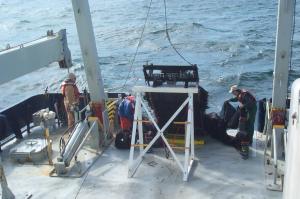
|
The RV Wecoma was towing an acoustics instrument that measured the intensity of backscatter from different sized scatterers in the water column. One of our goals during this three ship operation was to have the three ships together multiple times so that New Horizon MOC could sample discrete depths of high scattering observed by the acoustics package on the Wecoma. Also, we were interested in obtaining descriptions of the plankton abundances and types nearby the regions that the FV Sea Eagle was capturing juvenile salmon. We managed to deploy the MOCNESS several times during the cruise while the Wecoma was nearby (see photos), although it is to early to provide results of the acoustics-in water comparison.
|

|
MOC DeploymentPrior to lifting the MOC off the deck, the cod-ends are tossed into the water in an orderly fashion--to avoid tangles in the nets.
|
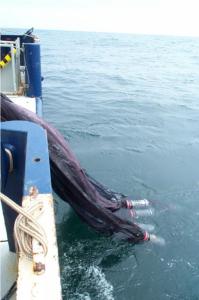
|
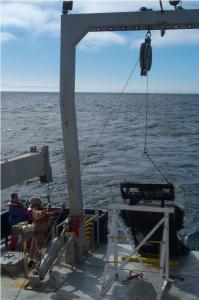
|
The A-Frame and winch are used to lift the MOCNESS over the side, while steadied by tag lines. The lines are released and the MOC is lowered to its maximum depth.
|
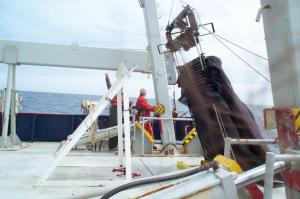
|
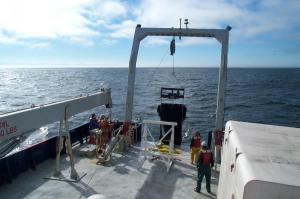
|
Ideally, while the MOC is descending to its maximum depth (350 meters, bottom depth permitting), the Wecoma steams by and radios us what depth they are seeing large amount of backscatter. We then target those depths with nets, although all depths are sampled, to provide identification of the scatterers and assist with calibrating the acoustic data set.
|
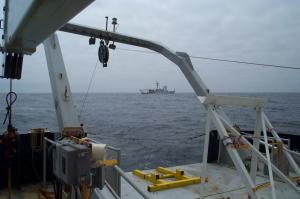
|
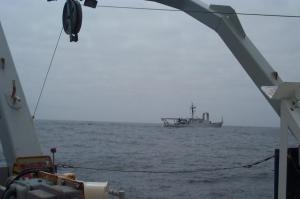
|
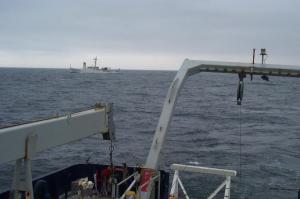
|
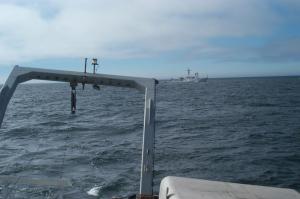
|
|
Sometimes the plankton watches were long and busy. After retrieving a MOCNESS, there might be up to an hour of work to rinse the nets, pickle and preview screen the sample contents, and reset the net for the next cast. Since some of the stations were only about an hour apart during the process studies portion of the cruise, there was barely time to finish one station before arriving at the next. Fortunately, we rarely MOCNESS'd two consecutive stations. Sometimes there was time between stations for other activities, like...
|
...catnaps, or...
|
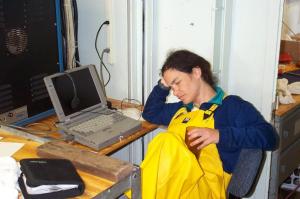
|
...videogames, or...
|

|
Here, Jay relaxes with a game of Pinball. Andrew was the "Pinball Wizard", even though he was born in the post Pinball era.
|
...fishing!
|
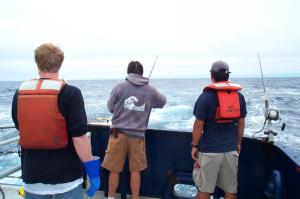
|
When we got far offshore into warm water, the crew and some of the scientists wetted their lines seeking the tuna.
|
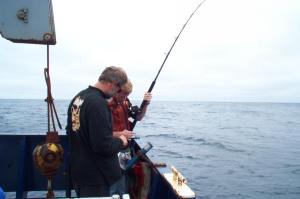
|
The captain shows Anders how to land the big ones.
The happy fisherman. The fish, however, is not so happy!
|
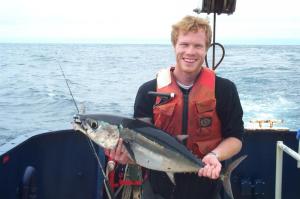
|
The Side Show
|
|
Sometimes there were interesting diversions from CTD'ing and MOCNESS'ing. Like the time the mail arrived. The delivery came by way of the RV Sacajawea,/I>, Oregon State's smallest research vessel, used for daytrips off of Newport, OR.
Closer...
closer...
|

|

|
|
The chief scientist awaits the package.
closer...
hi there!
|
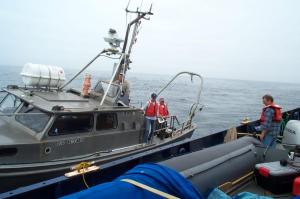
|

|
It's Jay Austin and he's delivering a baby boy--OOPS--a satellite image. In color, direct from Ted Strub at Oregon State.
And then the Sac is off again, not to be seen by us again.
|

|

|
|
We had other visitors as well. Like...
|
Petrels
|
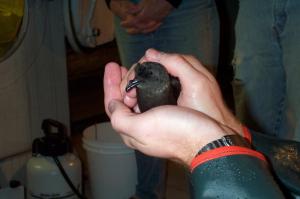
|
The Bird Observing Team
|
And speaking of birds, we carried along two bird observers.
|

|
Here, Larry and David scan from the bridge...
|
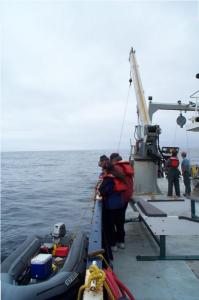
|
A couple of times they saw fronts with aggregations of birds, and we would stop the ship, deploy an inflatable, and Shad and David would go off for a closer view.
|
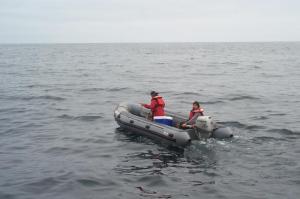
|
|
|
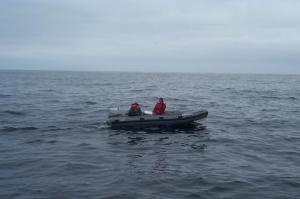
|
Shad (looking back) is thinking "I hope they don't leave us here!". David's thinking, "Let's go, there are birds over there!"
|
Cape Blanco
|

|
We sampled off Cape Blanco. The weather was perfect.
|
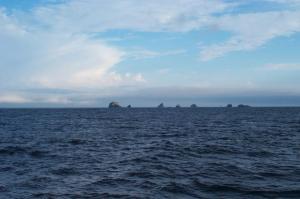
|
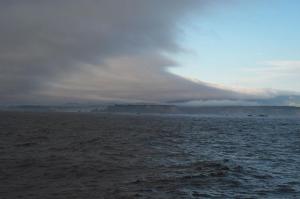
|
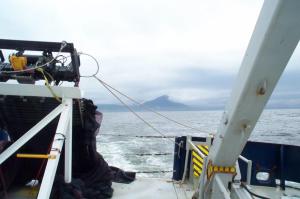
|
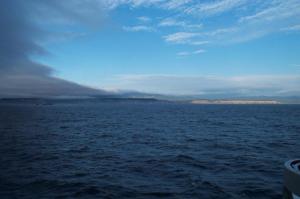
|
Nuts, oops, Nets
|
|
We used a vertical plankton net to quantify the abundance of smaller plankton. The mesh was .200 mm compared to the MOCNESS mesh of .333 mm.
|

|

|

|
We towed a large ring net for short periods and slowly to collect animals for experiments looking at molting rate and egg production rate. The contents of the cod end were dumped into coolers and then sorted into individual containers for the experiments.
|

|

|

|

|
The Endgame
|

|
We finished the cruise by sampling the Newport Line, near Yaquina Head. The weather was perfect.
Se Jong celebrates completion of the final station.
|

|





























































